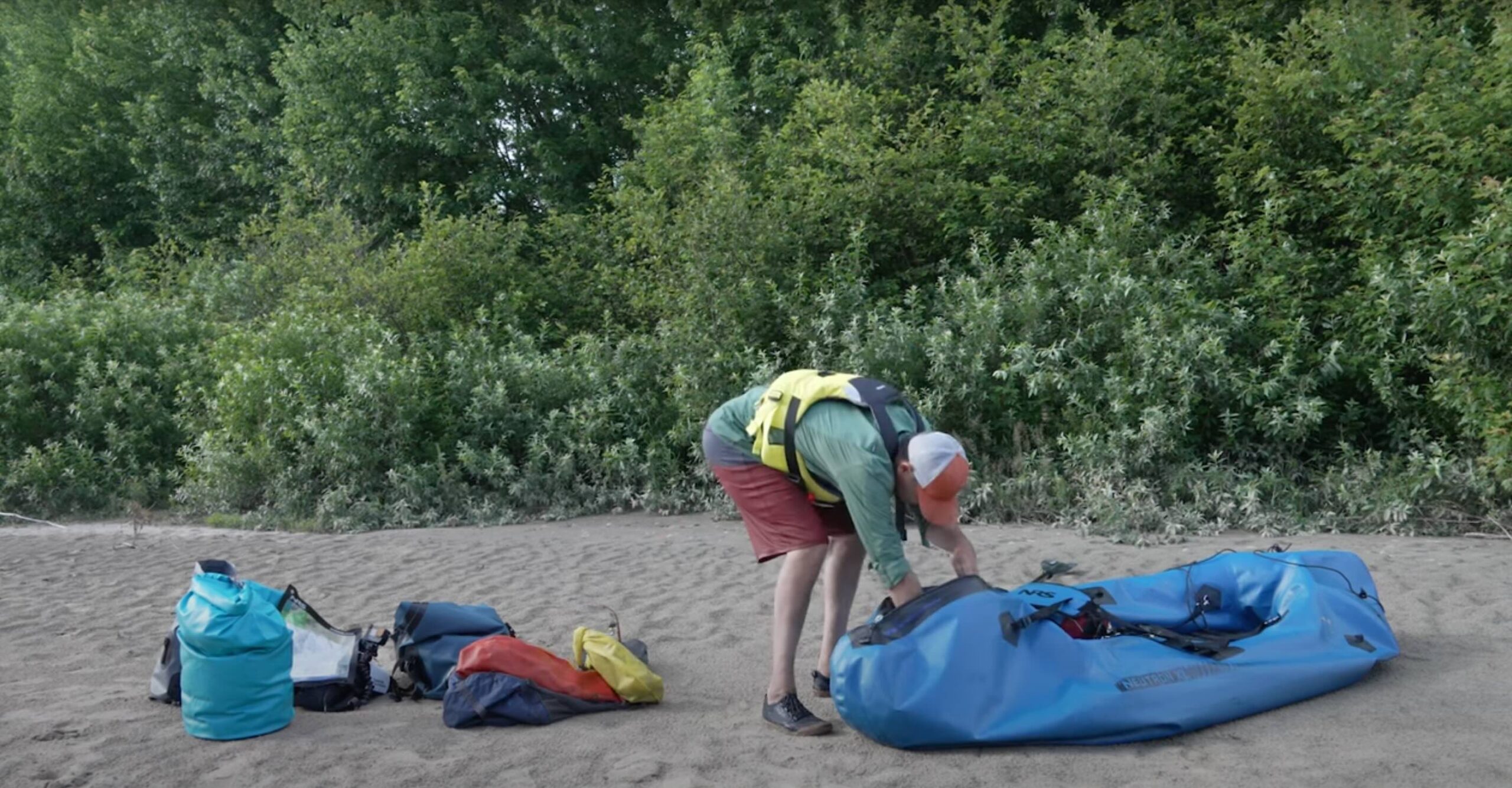Why Try Packrafting?
There are so many types of paddlecraft out there, so why has this new type of paddlecraft gained so much popularity so quickly?
Packrafts were initially designed to provide ultra-lightweight and highly portable paddle craft. The aim was to allow people to access more remote waterways in the backcountry. That is why packrafts are so small and light.
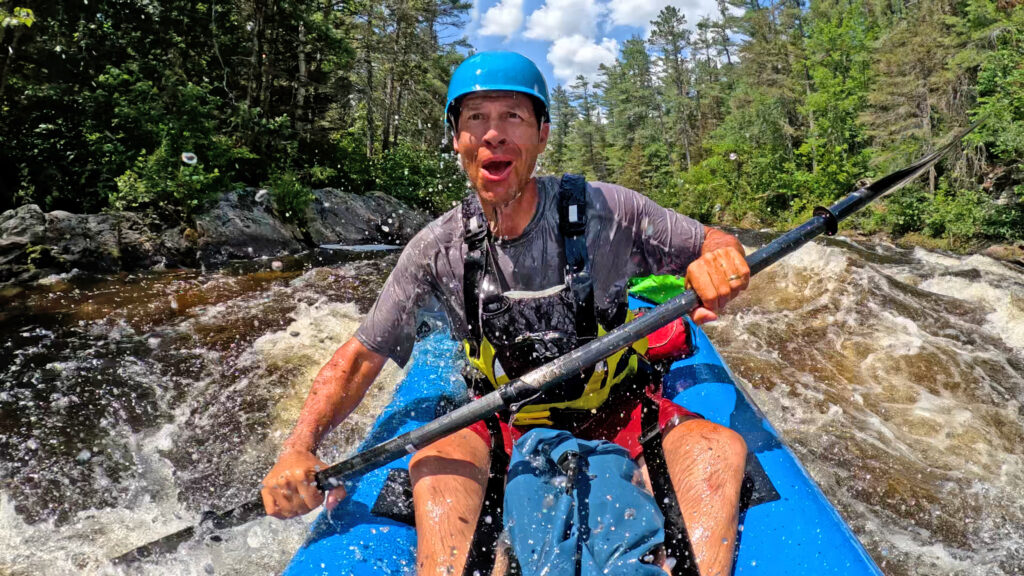
Paddling the Noire River while testing the NRS Neutron on my first overnight packrafting trip. Watch the full video.
The smallest packrafts available start at 5 pounds and are primarily for use on flat water. You can also find slightly heavier and more robust models designed for running whitewater rivers. Ultimately, the real benefits of using a packraft over other inflatable kayaks are that they are highly portable, ultralight, and let you access waterways in the backcountry.
The downside, when compared to other inflatable paddlecraft, is that they are slow and tend not to be as durable.
What are Packrafts?
Before we get further in, let's talk about what packrafts are. To simplify things, there are three main types of packraft:
- The bucket boat. Bucket boats are the most basic type of packraft. What makes them unique, is that any water that enters the boat, is going to stay there until you manually remove it. For this reason, bucket boats aren't ideally suited for rough water.
- The self-bailing packraft. Self-bailing packrafts have an inflatable floor and holes in the bottom, so that when water comes in, the inflatable floor floats to the surface, and the water then drains out of the holes in a secondary floor found below. These types of packrafts are designed for all-around use, from flatwater to class III whitewater.
- Decked packrafts. Decked packrafts are made to keep water out, and like a whitewater kayak, they're designed to be used with a skirt. This allows them to perform great in rough conditions, because they won't swamp. For that reason, decked packrafts can be used in the most challenging whitewater.
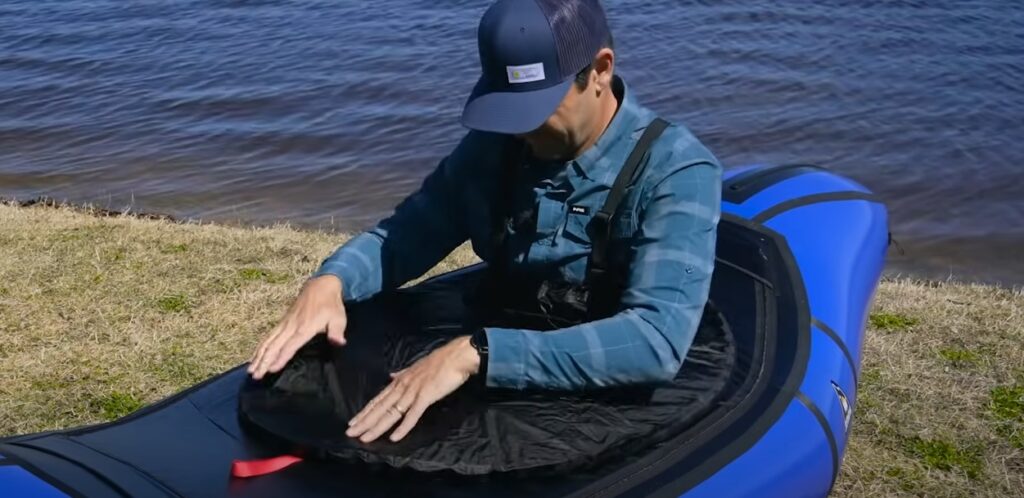
A decked packraft can be used with a skirt so that no water gets inside the cockpit area.
What are Packrafts Made From?
Packrafts are made from two primary materials: PVC and TPU-coated nylon.
PVC has been around for ages, and a lot of whitewater rafts are still made with it. PVC is one of the most economical materials because it is cheap and durable. The downside of PVC is that it is heavier, bulkier, and less compact than TPU-coated nylon. Given that the primary benefit of using a packraft is portability, bulkier PVC kayaks fall more into the realm of inflatable kayaks.
Packrafts are increasingly made from TPU-coated nylon because it is much thinner, lighter, and more compact than PVC. It is also more environmentally friendly. The downside of TPU-coated nylon is that it is a little less durable and more expensive than PVC.
But what is TPU-coated nylon? TPU stands for thermoplastic polyurethane. It is a membrane that is bonded to nylon. It provides a waterproof and highly durable protective layer on the nylon. Different boats have the TPU coating in different places. For example, some boats have a single layer of TPU on the outside where the main wear and tear will happen. Others have coatings of TPU on both the interior and exterior of the fabric, which makes for a more durable packraft, but adds some weight.
The other thing to note about TPU-coated nylon is that the nylon comes in different levels of thickness, from 210 denier up to 840 denier. The larger the number, the thicker and more durable the nylon fabric is, however, the heavier the packraft will be.
The Impact of Weight and Materials
To show the impact that the material has on weight, here are two packrafts I tested this year: the Alpacka Expedition and the NRS Neutron.
The Alpacka Expedition uses 210 denier nylon with TPU coating on one side. The floor is made from a heavier-duty 840 denier nylon with a dual coat of TPU.
In comparison, the NRS Neutron has the same floor (840 denier, dual-coated nylon), but the main body of this packraft is twice as ‘thick' as that of the Alpacka for added durability. It is made from 420 denier, dual TPU-coated nylon.
The result is that the Alpacka Expedition weighs 8.4 pounds, while the NRS Neutron is 12.2 pounds. This clearly shows that you need to make a decision about what's more important – durability, or weight savings.
Which Paddles Should I Use with a Packraft?
When it comes to paddles, the general rule is that the wider the boat and the higher you are sitting, the longer the paddles need to be. For example, you need very long paddles when using sit-on-top kayaks, which are wide and place the paddler high above the water. On the other hand, whitewater paddles and sea kayak paddles are much shorter because the kayaks are narrower and the paddler sits on the floor, below water level.
Packrafts are very wide and stable. However, you sit fairly low in the water. To give you a ballpark length, you should look at using paddles between 215 and 225 cm long. If you are using a whitewater packraft, you will want to be at the lower end of this spectrum. If you are doing flatwater paddling, then you will want slightly longer paddles.
Packrafting Safety
First and foremost, when it comes to any sort of activity on the water, be it kayaking, canoeing, or packrafting, you need to wear a PFD. PFD stands for “personal flotation device”, or, as a friend recently said to me, “pretty freaking dumb” not to be wearing one!
A safety issue to consider that is unique to packrafts, is that unlike other inflatable kayaks, packrafts typically only have one air chamber. Other inflatable kayaks usually have three air chambers. With three air chambers, if one gets punctured while you're on the water, you will still have two air chambers keeping the boat afloat. Because the packraft relies on only one air chamber, if you get a puncture, your boat will lose all its flotation. This is why you should always bring a repair kit with you.
One way that packrafts can break, usually irreparably, is by over-inflating and exploding them. Packrafts are not designed to be inflated as rigidly as other inflatable kayaks. In fact, TPU-coated nylon packrafts are supposed to be inflated to around 1 or 1.5 PSI.
How to Stop Your Packraft Overinflating
When you are out in the sun all day, the air pressure in your packraft can change. The heat from the sun will increase the air pressure, while cold water or a dropping temperature can reduce the air pressure in your packraft. This is why you need to monitor the pressure levels of your packraft throughout the day, and why you should bring the inflation bag with you.
The biggest concern, is having the air pressure increase so much that the boat ‘pops' like a balloon. This is unlikely to happen when you're on the water, because the water helps keep the packraft cool. However, if you take a break on shore, and leave your packraft under a hot sun, it could burst. To avoid this, leave the boat in the shade, or tie the boat up and leave it floating on the water. You can also shield your boat from the sun by laying your PFD and gear over it, or you can cool it down periodically by splashing the boat with water. If necessary, you may even want to let a little air out to reduce the pressure.
Storage in a Packraft
One of the coolest things about packrafts is that they offer the opportunity to use the inside of the boat as gear storage, which is amazing for multi-day trips.
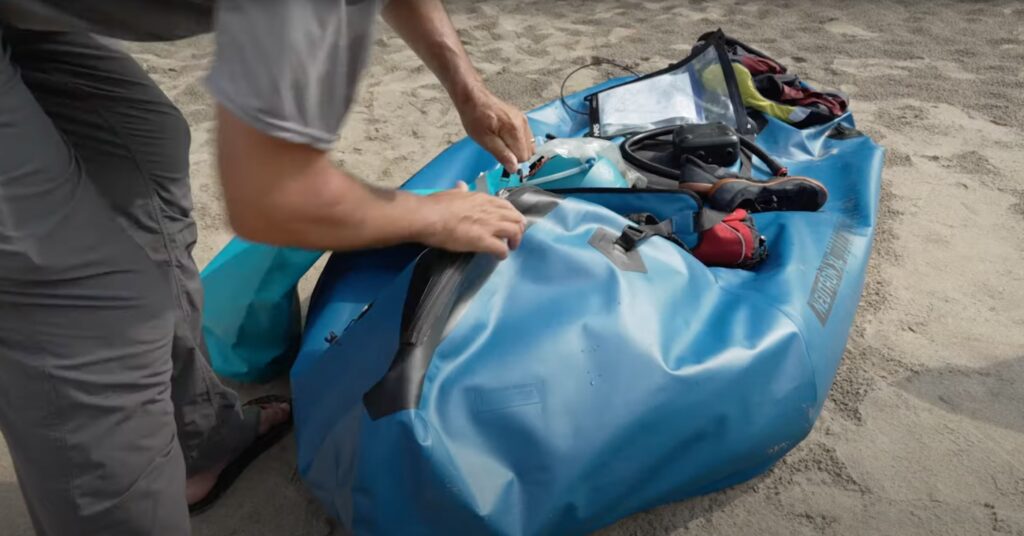
Take Care of Your Tie Zip Closure
A lot of packrafts have tie zip closures. These are big zippers that can be used to fully open the boat up and let you put gear inside.

There are a couple of things that you need to know about tie zip closures if you intend to use them. Firstly, they are the most sensitive parts of the boat. You must, therefore, treat them very well. Things like sand and dirt are killers for the zipper system. The sun can also pose problems by drying the zippers out. To stop the zipper from drying out and make it much easier to use, you should put a regular treatment on it.
All in all, treat the zipper like it is your best friend because it is. It can be a major problem if the zipper fails when you are out and about. If the zipper fails, the boat is completely compromised.
Store Gear Sensibly
When using the inside of a boat to store gear, you should always assume that it will get wet, even if theoretically it shouldn't. With this in mind, you should always put stuff in dry bags.
Most packrafts designed for multi-day trips will have attachment points inside for you to clip your gear onto. This is so that when you are paddling through rough water, your gear will not be sliding all over the place.
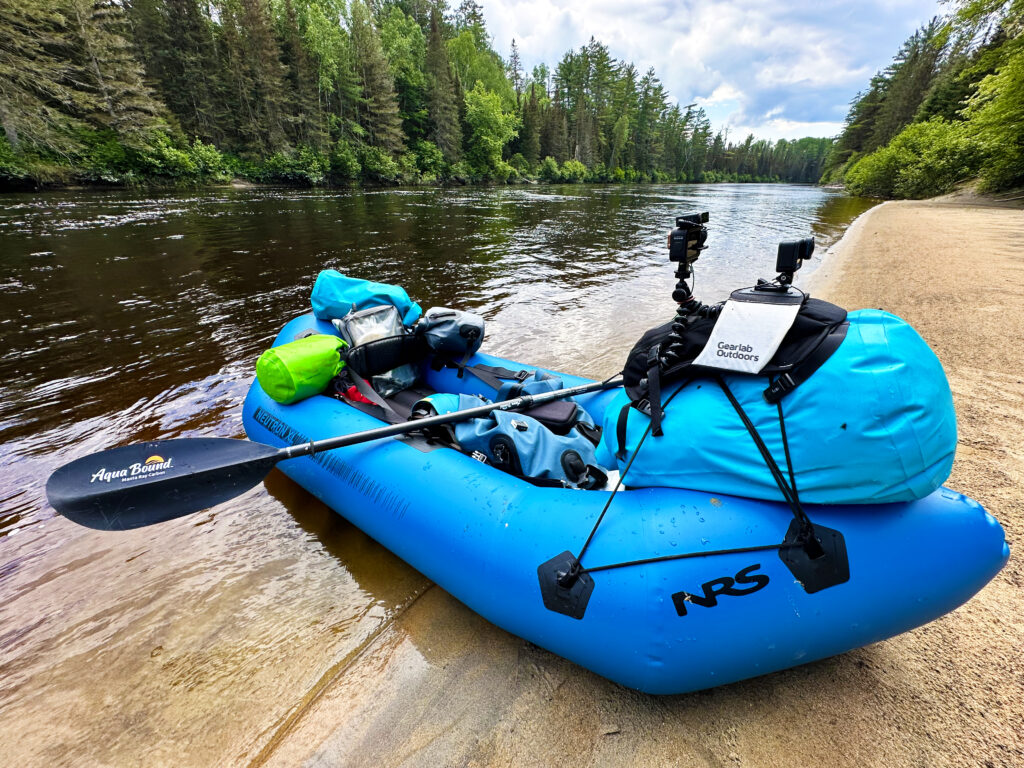
When putting gear in the boat, it is important to consider how you want to distribute the weight. Ideally, you would like to distribute the weight evenly through the packraft.
However, if you are going to have more weight on one side, it is best to keep it at the back of the boat. If you have more weight in the back of the boat, the front will be slightly higher. This means that you will be plowing less water when moving forward. When paddling in flat or whitewater, the distribution of weight can make a big difference. It is important to note that if you have too much weight in the back, you will be dragging the back down. You want it to be as balanced a load as possible.
One last little tip that I would give when it comes to storage is that if you are putting anything hard inside the boat, think about wrapping it in something soft like clothes. This means that if you hit a rock, the material of the packraft will be a little padded.
Paddling a Packraft in Current
In general, it is a bad idea to try paddling in any whitewater beyond class one (which is just moving water) without having received some sort of instruction beforehand. When paddling in whitewater, things can go wrong and become serious very quickly. Understanding what is going on with the water allows you to make smart decisions and avoid getting in trouble.
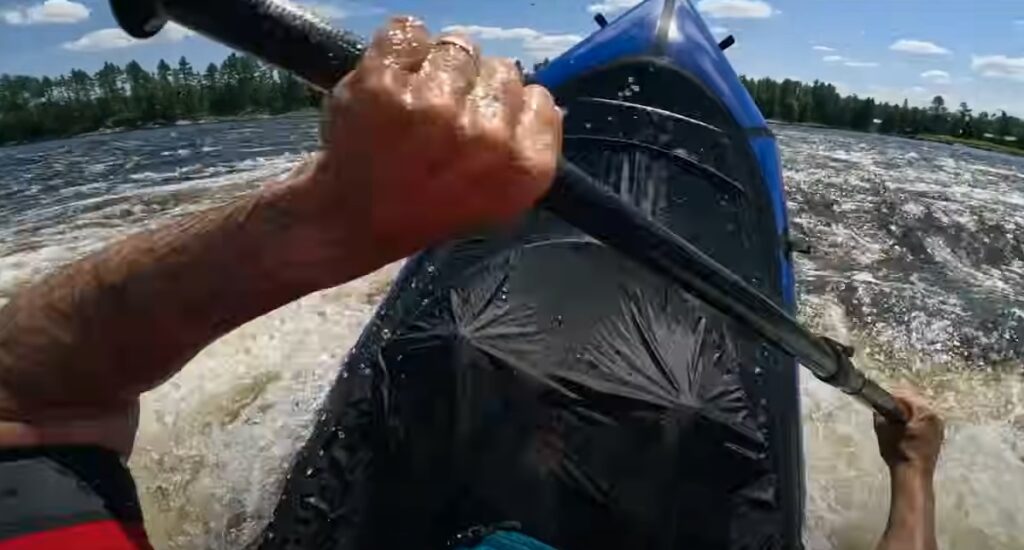
Packraft Outfitting
Some really useful accessories can help you out when using a packraft in whitewater. For example, it can help to have a high-performance backband. A backband that provides good support for your back and is not just an inflatable support designed for lounging.
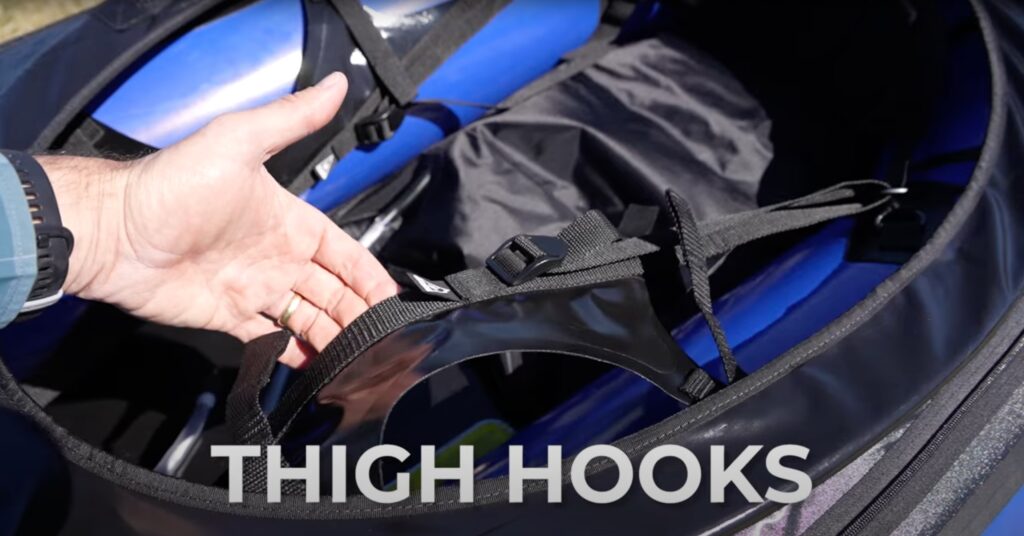
You don't need high-performance thigh hooks. But if you have something that your knees can slip under, it will give you more control over the boat. Using thigh hooks is comparable to wearing a pair of Trail Runners. When you do not have thigh hooks, it's more like you are wearing flip-flops. You aren’t as attached to the boat, so will have less control when it bucks around. Thigh hooks help make you feel like one with the boat and give you a lot more control.
Rolling a Packraft
You can roll a packraft, however, it's not too easy. The wider a boat is, the more difficult it is to roll. Given that packrafts are very wide, you need to have good technique to roll one. If you try to roll it with more muscle and less technique, you can risk hurting yourself. That is why when I was testing the Alpacka Expedition in rough conditions. I decided right at the beginning that I would not roll the kayak if I flipped. I've been dealing with a shoulder issue. The last thing I wanted to do was risk doing more damage by rolling a big, wide boat.
If you want to learn to roll your packraft you need good technique. I would suggest learning it first with a whitewater kayak.
What Grade of Whitewater Can You Use a Packraft in?
Packrafts that have decks and are designed to be used with a skirt can handle some really challenging whitewater. They can be used in up to class 4 whitewater if you have the skills. That said, it is important to realize that packrafts are not as high-performance as a real whitewater kayak. They don't give you the same level of edge control that you have in a whitewater kayak. Packrafts do, however, provide both incredible stability and incredible maneuverability, which makes them a very forgiving boat.
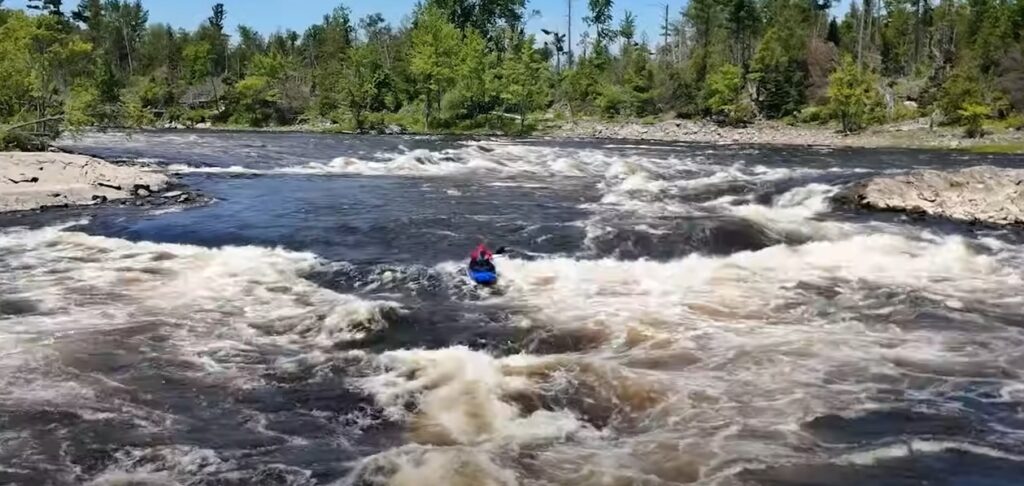
The furthest you can safely take a self-bailing packraft is class three whitewater which is not overly technical. This is because if you hit a big wave and the water swamps you, it will not drain quickly enough to continue down the rapids. Until it drains, you will have extra weight in the boat making the packraft far less maneuverable. You will not be able to set up for the next move that you need to make in the rapids. Self-bailing boats are not great for technically challenging whitewater, but they are great for fun class one, two, and even some class three whitewater.
Bucket boats do not have any way to drain water. They are not protected from swamping. So they are only good for flat water and class one moving water.
While I've been paddling for 35 years, I've only been packrafting for a year. I am still learning a lot about packrafts. That said, after having an absolute blast doing my first multi-day trip in one this summer, I am looking forward to doing more pack rafting trips in the future.



